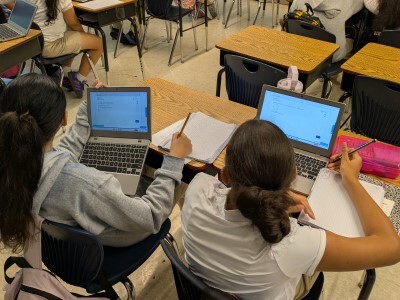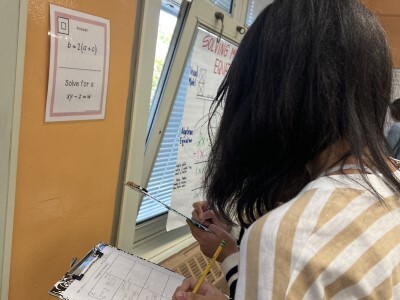Education Equity in the Age of COVID
Topics
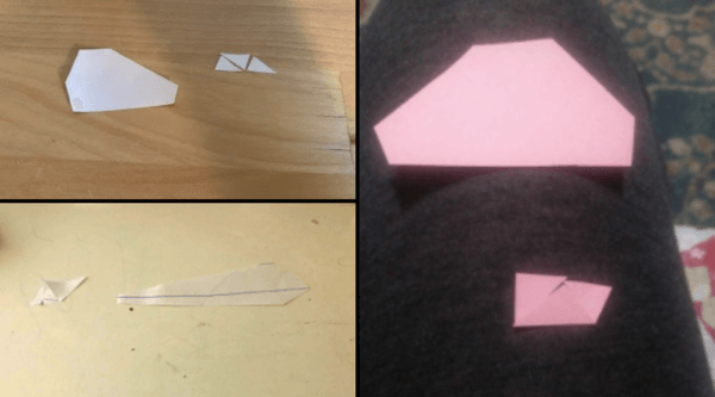
We’ve all had the experience of truly purposeful, authentic learning and know how valuable it is. Educators are taking the best of what we know about learning, student support, effective instruction, and interpersonal skill-building to completely reimagine schools so that students experience that kind of purposeful learning all day, every day.
Three ways to create more entry points to learning online during the pandemic and close learning gaps, using strategies learned from adopting blended learning in the classroom.
The uprising that has taken place across the country over the last few weeks is pushing us all to think about what we can do to support Black lives. As a middle school math teacher in an urban charter school, one clear answer is do my job better. That means working to create greater equity in my classroom by meeting students where they’re at and helping them grow. But in the age of COVID, it’s a lot harder to do that. We no longer share the same structured physical space where I can better support a variety of learning styles and deliver specific, immediate, and actionable feedback. So what does pushing education equity look like in distance learning?
A lot of what we hear in the news about education equity is focused on access. Many students don’t have the resources or capacity at home to engage in distance learning and that’s a huge problem. But as any teacher will tell you, being present is not the same as learning. As we continue to address access to distance learning, we need to also address the inequities that will be perpetuated because of distance learning if we limit ourselves to posting video lectures and assigning practice problems. We need to ask ourselves as teachers, what strategies and tools can we use to engage every learner in a digital environment? This is something I’ve been asking myself a lot since the beginning of last year.
When the 2019-2020 school year began, I rolled out a blended learning classroom model in my math classes with the support of the Modern Classrooms Project. In theory, blended learning should support equity in the classroom. Students can work through lesson videos at their own pace and the teacher is free to provide more individualized and targeted support.
But, this wasn’t my experience with blended learning in the beginning of the year. What I found was that some students were thriving in blended learning, but many were totally lost. Blended learning was actually widening the gap of mathematical understanding among my students, not closing it. I spent the rest of the year modifying my blended learning structure and by the time distance learning started, my blended learning model was engaging almost every student and closing the learning gap among my students. Without knowing it at the time, the work I’d done had prepared them for the realities of COVID.
Here are some things I’ve learned this year about how to make online learning more equitable.
Video Learning Is a Set of Skills
My first big mis-step when rolling out my lessons as videos is that I didn’t explicitly teach students how to learn using videos. It turns out that a lot of middle schoolers don’t know how to watch videos about math. They aren’t sure what to write down and when. They don’t always realize that they can pause and go back over something they missed or how to do it. And they don’t know how to organize their notes so that they can refer back to them later. So I went back and explicitly taught these skills so that all students could engage in the content.
I also strengthened my class routines to support the development of these skills. In the beginning of the year, a lot of students complained that they couldn’t focus on a lesson video because it was too loud in the classroom. Often this noise was from other students legitimately engaging in math activities. So, I started designating the first part of class as silent video watching or independent work time. I wrote a checklist of steps for completing the lesson each day with estimated time of completion and reviewed it with students at the beginning of each class. For me, this is when the learning really started happening. Students now had the structure and skills they needed to succeed in a self-paced environment.
This translated really well to distance learning. I would encourage any teacher in a distance learning environment to start by teaching your students how to best engage in an online learning environment before teaching actual content. Also, structure their online time and share that structure with them so that they’re clear about what they are working on.
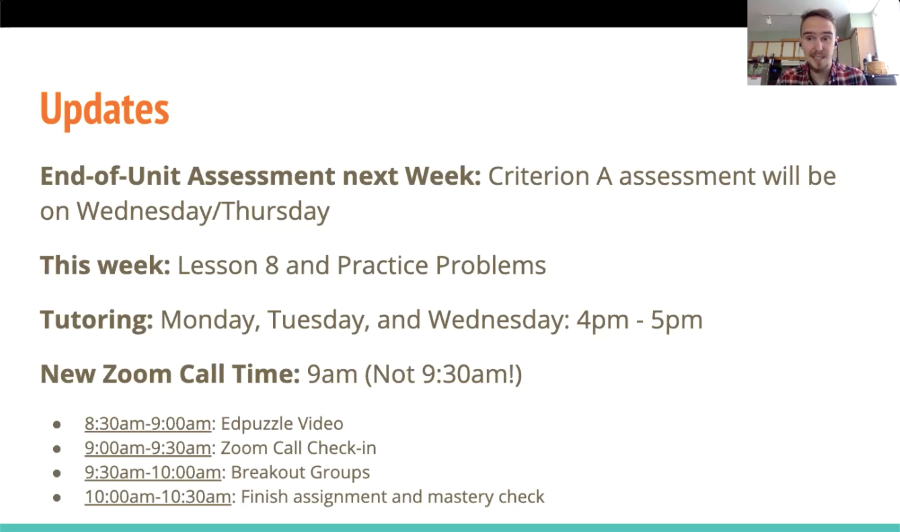
Break up the Video Monotony
Ultimately, I believe that video is a pretty good mode of learning and spent a lot of time this year perfecting that pretty good mode of learning. But videos didn’t always achieve the depth of learning that I wanted, especially for my tactile learners. So for next year, I’m thinking a lot about how to complement blended learning with more engaging activities for students.
This might seem harder in a distance learning context, but I think it poses some interesting opportunities. What high-quality digital manipulatives could students explore? What common household items might students use to enhance their learning, not just in math, but in all subjects? For students who are struggling with videos, these could be strategies that you use consistently. But, I think every student can benefit from breaking up the video monotony with a more tactile activity.
In our geometry unit this year, I made a video about the properties of triangles. I showed how, if I pulled the corners off of a triangle and put those corners together, they form a straight line which students knew is equal to 180 degrees. That meant that the sum of the angles of this triangle is 180 degrees, but is this true of any triangle? In my video, I challenged students to make their own triangles out of any piece of paper, rip off the corners of the triangle, and see if they could make a straight line too. When I joined our Zoom call check-in, I was surprised and excited by how many students were eager to share the results of their triangle experiment. Needless to say, my students never forgot the sum of the interior angles in any triangle.
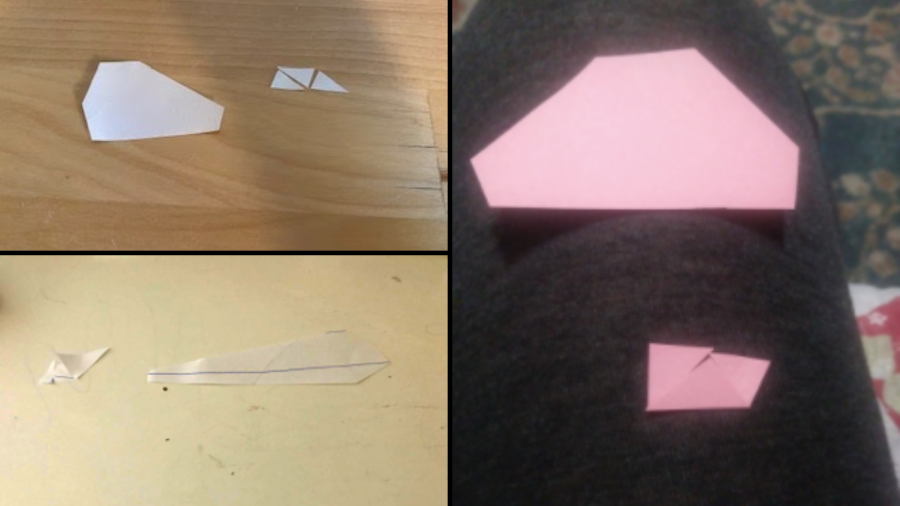
Be Proactive in Your Checks for Understanding
In a traditional classroom with a teacher teaching at the board, it’s pretty easy to spot students who don’t understand what’s going on. They are typically either frozen or off-task. Effective teachers address their confusion in the moment, bring them back into the lesson, and keep the class moving. It’s a lot harder to spot students who are confused in blended learning. Everyone is working more independently so students who are lost have a harder time signalling to the teacher that they are confused. In theory, they would ask for help but many students are afraid to admit that they need help and will just sit there stuck if you let them.
I learned that I couldn’t wait for students to ask me for help and became much more proactive with my checks for understanding. With the extra class time I gained from recording my instructional videos in advance, I broke up my class into learning groups based on recent exit ticket performance or learning style to better support their needs. This translated really well to distance learning. I used Zoom breakout groups to set up small groups where I could work with students who seemed to be stuck. I set the Zoom chat function so that students could only chat with me, and then I asked a check for understanding question that the entire class was expected to answer. This allowed me to see who was struggling and who wasn’t paying attention in a way that felt safer for students.

Like many teachers around the country, I’m planning to start the next school year with distance learning. It seems that a lot of teachers are focused on managing the learning loss, but the uprising for racial equality that is taking place in our country demands more than that. We must find ways, in the age of COVID, to deliver the differentiated and equitable education that our young people need right now. And when we return to the classroom, instead of discarding distance learning and returning to the norms of physical school, let’s bring the two together and revolutionize education in America. What strategies will you use to deepen education equity in your class next year?
All images courtesy of Ryan Steinbach.


